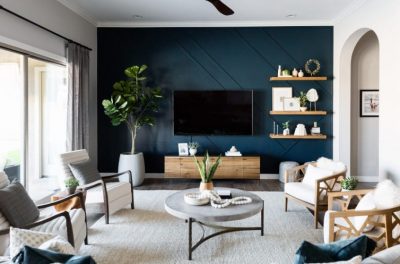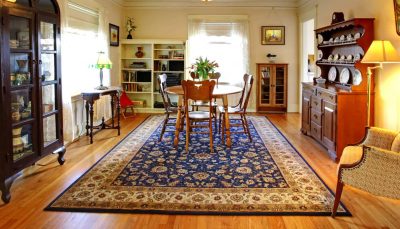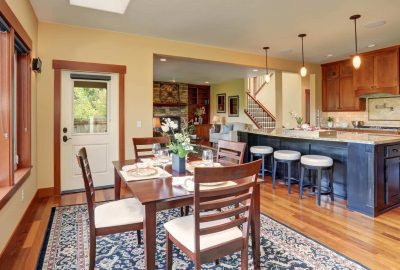AcaciaHardwood floors can transform the look and feel of any room. With so many types of hardwood floors to choose from, it can be overwhelming trying to select the right type of hardwood flooring for your home.
In my wood floor roundup, I’ll walk you through the pros and cons of different types of wood used for hardwood floors, categories, uses, and costs to help you make an informed decision. Whether you prefer a traditional wooden oak floor or an exotic Brazilian cherry, there’s a hardwood floor perfect for your lifestyle and budget.
| Type | Appearance | Pros | Cons | Best Use | Price |
|---|---|---|---|---|---|
| Oak | Light tan with visible grain | Affordable, Versatile | Prone to scratches and dents | High traffic areas like kitchens, family rooms | $$ |
| Maple | Pale white to light brown with straight grain | Durable, Ages well | Prone to dents and scratches | Formal spaces like dining rooms | $ |
| Hickory | Dramatic bold grain in varying colors | Extremely durable | Expensive, Difficult to install | Rustic, dramatic spaces | $$$ |
| Birch | Pale yellow to reddish brown with straight grain | Attractive grain, Durable | Prone to scratches | Bedrooms, living rooms | $ |
| Walnut | Rich dark brown with flowing grain | Elegant, Luxurious | Expensive, Prone to scratches | Formal living rooms | $$$$ |
| Cherry | Ranges from red to reddish brown | Ages beautifully | Prone to fading and scratches | Dining rooms, bedrooms, offices | $$$ |
| Red Oak | Pink to light reddish brown with large pores | Affordable, Durable | Prone to scratches and dirt | Family rooms, recreation rooms | $ |
| White Oak | Light to dark tan with minimal grain | Moisture resistant, Ages well | Expensive, Stains unevenly | Kitchens, bathrooms | $$$ |
| Cork | Natural tan, no wood grain | Soft, Warm, Eco-friendly | Not very durable | Playrooms, bathrooms | $ |
| Brazilian Cherry | Rich reddish brown | Extremely durable | Expensive, Difficult installation | High traffic areas | $$$$ |
| Bamboo | Blonde to caramel color | Renewable, Durable | Can dent, Manufacturing concerns | Kitchens, dining rooms | $$ |
| Ash | Pale white to light brown with bold grain | Durable against scratches | Fades to yellow in sunlight | Bedrooms, recreation rooms | $ |
| Teak | Yellowish-brown with leather-like smell | Moisture resistant | Expensive, Raising depletes rainforests | Bathrooms, porches | $$$$ |
| Eastern Black Walnut | Dark chocolate brown with flowing grain | Unique color and grain | Stains easily | Living rooms, studies | $$ |
| Brazilian Walnut | Rich dark brown with dark streaks | Dramatic color, Hard and durable | Very expensive | Formal living rooms | $$$$$ |
| Mahogany | Reddish brown with distinctive grain | Durable, Ages well | Expensive, Overharvesting concerns | Studies, bedrooms | $$$$ |
| Black Cherry | Dark reddish-brown | Ages beautifully | Expensive, Difficult repairs | Dining rooms, studios | $$$$ |
| Acacia | Pale yellow with dark grain and knots | Durable, Moisture resistant | Prone to dents | Hallways, kitchens | $ |
| White Ash | Pale white to light brown | Light color shows grain | Not as durable, Stains unevenly | Kids’ rooms, recreation areas | $ |
| Wenge | Very dark brown with bold grain | Dramatic, Moisture resistant | Expensive, Requires maintenance | Living rooms, studios | $$$$ |
| Sapele | Reddish brown with interlocking grain | Scratch resistant | Expensive, Difficult to finish evenly | Libraries, living rooms | $$$ |
Types of Wood for Hardwood Floors
When starting your hardwood floor shopping journey, one of the first decisions you’ll make is which wood species best fits your style and needs. The natural color, grain patterns, hardness, and overall durability of the wood will impact how your floor performs.
Here is a table summarizing the key information for each type of hardwood flooring:Here are some of the most common species used for hardwood flooring and their characteristics:
Oak
This classic American hardwood never goes out of style. Red oak is the most prevalent species, appreciated for its versatility and affordability. White oak is harder and has an attractive wavy grain. Oak accepts stains well if you want to customize the color. It holds up to heavy traffic and resists wear from pets and kids. Oak is a great choice for formal and casual design styles.
- One of the most popular choices, oak has a light tan color and distinctive grain pattern. It is very durable.
- Pros: Affordable, abundant, durable, ages well
- Cons: Can dent or scratch more easily than some woods
- Best Use: Works well in most rooms, especially high traffic areas
- Reasons to Choose: Versatile, abundant, affordable, ages beautifully
Maple
Prized for its creamy white color and smooth, fine grain, hard maple is one of the hardest domestic wood species. It has a clean, contemporary look. Maple is durable against scratches and high traffic areas. Use extra protective finishes in kitchens and baths. Stains to change its color are optional. Maple coordinates well with modern, farmhouse, and traditional décor.
Hard, durable wood with creamy white tones.
Pros: Easy to maintain, durable finish.
Cons: Scratches and dents show.
Best Use: Modern, contemporary spaces.
Reasons to Choose: Light color, smooth grain.
Hickory
Extremely hard and dense, hickory has a bold grain pattern that pairs nicely with rustic designs. The wood has natural color variation ranging from light tan to chocolate brown. Hickory is ideal for open floor plans and kids and pets. Resists scratches and indents. Use caution with stains, as hickory absorbs unevenly.
Extremely hard and durable wood with bold grain patterns.
Pros: Scratch and indent resistant, good for high traffic areas.
Cons: Absorbs stains unevenly.
Best Use: Rustic, casual styles.
Reasons to Choose: Durability, richness of grain.
Birch
A nice alternative to maple with good durability at a lower cost. Birch has a tight, straight grain that stains uniformly. The wood lightens to a pale yellow over time when exposed to sunlight. A versatile species that works with many home styles thanks to its flexibility with stains and finishes.
Nice alternative to maple, works with many styles.
Pros: Takes stains well, durable.
Cons: Prone to dents.
Best Use: Traditional, farmhouse, and eclectic decor.
Reasons to Choose: Affordability, flexibility.
Walnut
Prized for its rich brown color with dark grain, walnut has long been a top choice for high-end homes. It adds a formal elegance to living spaces. The smooth texture mellows over time. Prefinished walnut has increased demand, making solid walnut more attainable. Use large area rugs in high traffic areas to preserve its beauty.
Rich dark brown color with flowing grain pattern. Scratches and dents easily.
Pros: Timeless, elegant look. Goes well with many furniture styles.
Cons: Expensive, scratches and dents easily, difficult to refinish
Best Use: Formal living rooms, studios
Reasons to Choose: Rich, luxurious color and grain
Cherry
A luxury domestic wood appreciated for its reddish-brown color and flowing grain pattern. New floors have a bright cherry tone that darkens over time. Dents and scratches are fairly visible. Consider a low-gloss finish for a classic parquet flooring look. Use area rugs to protect high traffic areas.

Ranges from rich red to reddish brown in color. Ages beautifully over time.
Pros: Ages beautifully, resin gives natural shine, matches many furniture styles
Cons: Can fade with sun exposure, scratches and dents fairly easily
Best Use: Dining rooms, bedrooms, home offices
Reasons to Choose: Ages beautifully with rich patina
Red Oak
The most common oak species, red oak is known for its pinkish-red tint and distinctive grain patterns. It is affordable, versatile, and durable enough for high-traffic areas. Red oak accepts stains well and pairs with many design styles from casual to formal.
Classic hardwood with nice grain patterns.
Pros: Affordable, versatile.
Cons: Can dent with heavy impacts.
Best Use: Traditional and casual styles.
Reasons to Choose: Timeless appeal, easy to match with decor.
White Oak
Prized for its attractive, wavy grain, white oak is paler and harder than red oak. Its versatility works with farmhouse, modern, and traditional decor. White oak is very durable and scratch resistant, though more expensive than red oak.
Very hard oak species with wavy grain.
Pros: Scratch resistant, ages well.
Cons: Expensive.
Best Use: Traditional and modern styles.
Reasons to Choose: Durability, distinctive grain.
Cork
A unique sustainable option, cork has a rich, natural look and soft feel underfoot. It provides warmth and noise insulation. Cork resists mold, mildew, and pests. Easy to install and maintain, cork adapts well to concrete subfloors.
Soft, comfortable surface made from renewable source.
Pros: Insulating, sustainable.
Cons: Not very durable or easy to repair.
Best Use: Bedrooms, family rooms, eco-friendly homes.
Reasons to Choose: Natural feel, warmth.
Brazilian Cherry
With a rich reddish-brown color, Brazilian cherry has an exotic look. The grain is usually straight with some figuring. Durable and scratch-resistant, it withstands moisture. The luxurious appearance works well in formal spaces.
Exotic import valued for its richness.
Pros: Unique bold grain and color.
Cons: Softer than traditional woods.
Best Use: Formal spaces and accent walls.
Reasons to Choose: Visual appeal and formal elegance.
Bamboo
A renewable grass, bamboo offers a durable and eco-friendly flooring option. It has a light tan appearance and sleek, modern look. Bamboo is very hard and resists scratches, dents, and moisture damage. It provides a stylish, affordable alternative to hardwood.
Eco-friendly alternative to hardwood.
Pros: Sustainable, scratch resistant finish.
Cons: Prone to scrapes and grit indentations.
Best Use: Contemporary, eco-friendly spaces. Reasons to Choose: Affordability, sustainability.
Ash
Light in color like oak, ash has an open, coarse grain that creates an interesting pattern. The wood is strong and flexible. Ash costs less than exotic woods but provides a similar look. Staining ash produces a range of effects from bold to subdued.\
Hard wood with distinct grain.
Pros: Versatile, affordable.
Cons: Prone to dents.
Best Use: Contemporary, rustic styles.
Reasons: Budget-friendly, wide range of stains.
Teak
Used for centuries in shipbuilding, teak is incredibly strong and durable. Its oily finish and tight grain make it very weather and moisture resistant. Teak has a light to medium golden brown color. It’s suitable for indoor and outdoor use in any climate.
Tropical luxury hardwood.
Pros: Extremely durable, water-resistant.
Cons: Very expensive.
Best Use: Outdoor spaces, patios.
Reasons: Hardness, natural weather-resistance.
Eastern Black Walnut
Native to eastern North America, black walnut heartwood has a rich, chocolate-brown color with darker streaks. The wood is strong, stable, and naturally decay resistant. Black walnut creates an elegant, upscale look in any room.
Rich chocolate brown wood.
Pros: Formal elegance, ages well over time.
Cons: Rare and costly.
Best Use: High-end traditional homes.
Reasons: Distinctive patina and grain.
Brazilian Walnut
With vivid streaks in shades of brown, Brazilian walnut has a lively, exotic look. It has good hardness and durability. The irregular grain patterns and varied colors add interest. Brazilian walnut lends a tropical flair to contemporary spaces.
Exotic alternative to domestic walnut.
Pros: Dynamic grain patterns and colors.
Cons: Softer than traditional woods.
Best Use: Accent walls, formal spaces.
Reasons: Unique visual appeal.
Mahogany
A classic luxury wood, mahogany has a reddish-brown hue that darkens over time. It has excellent workability and takes detailed carving well. Mahogany is durable but not as hard as some exotics. Its refined beauty fits formal spaces and elegant decor.
Sophisticated reddish-brown wood.
Pros: Luxurious depth of color. Cons: Scratches and dings show.
Best Use: Historical reproductions, libraries.
Reasons: Timeless warmth and beauty.
Black Cherry
Known for its luxurious, reddish-brown color, black cherry pairs well with classic and contemporary styles. The smooth, straight grain has a sophisticated look. It is strong and stable. Black cherry gives spaces a rich warmth.
Subtle reddish tones that deepen over time.
Pros: Flowing grain patterns, formal look.
Cons: Shows scratches easily.
Best Use: Traditional living spaces, studies.
Reasons: Elegant patina.
Acacia
Typically light yellow with varied grain patterns, acacia has an attractive natural look. The hardness and durability make it suitable for high-traffic areas. Acacia is affordable, eco-friendly, and pairs well with modern, beach-inspired spaces.
Exotic wood with varied grain colors.
Pros: Hardness and durability.
Cons: Difficult to stain evenly.
Best Use: Casual living spaces.
Reasons: Affordable exotic option.
White Ash
Light, almost white in appearance, white ash has a clean, subtle grain pattern. It is strong and durable enough for heavy foot traffic. White ash stains easily to customize the tone. It fits Scandinavian, modern, and transitional spaces nicely.
Light brown domestic wood.
Pros: Budget-friendly, takes stains well.
Cons: Prone to dents.
Best Use: Kids’ rooms, casual family spaces.
Reasons: Value, ability to re-stain.
Wenge
An exotic African wood, wenge has a nearly black background with brown streaks that create bold grain patterns. The wood has a contemporary, sleek look. Wenge is very hard and durable. It makes a sophisticated style statement.
Dramatic dark exotic wood.
Pros: Remarkable black grain patterns.
Cons: Scratches and scrapes easily.
Best Use: Accent walls or borders.
Reasons: Statement-making visual impact.
Sapele
Similar to mahogany, sapele has a vibrant red or purple-brown tone when freshly milled. It darkens over time. The interlocked grain has a ribbon-like appearance. Sapele is strong and durable for high-traffic areas.
Reddish brown with interlocking grain that darkens over time
Pros: Scratch and moisture-resistant; distinctive appearance
Cons: Can be difficult to finish evenly; expensive
Best Use: Libraries, studies, living rooms
Reasons to Choose: Dramatic grain; durability
Types of Hardwood Flooring
In addition to choosing a wood species, you’ll also decide between solid or engineered construction. The thickness of the wood, installation method, and price differ between the two main types.
Solid Hardwood Flooring
As the name implies, solid hardwood flooring is milled from a solid piece of wood. The planks are thicker, typically 3/4″ thick. Solid wood floors are sanded and refinished multiple times, so they can last 100 years or more. This makes them a good investment.
Pros:
– Can be refinished many times
– Highly durable and will last lifetimes
– Retains value well
Cons:
– Most expensive option
– Not recommended below grade or over radiant heat
– Prone to gapping with fluctuations in humidity
Solid woods like oak, hickory, and maple are ideal for heirloom-quality floors. Use in main living areas and upper floor levels. Various plank widths and patterns add custom styling.
Engineered Hardwood Flooring
Engineered wood consists of multiple layers of thin solid wood adhered to a core of plywood or high-density fiberboard (HDF). The top layer of solid wood is typically 3-7 mm thick. Beneath it are several cross-plied layers of wood veneer.
Pros:
– More affordable than solid wood
– Resists moisture better, good for basements
– Installs well over radiant heat systems
Cons:
– Cannot refinish as many times as solid wood
– Avoid excessive moisture
Popular for the price and dimensional stability. Ideal for floating floors in renovations or over concrete. Durable for everyday wear and tear. Use premium plywood or HDF cores only.
Bamboo Flooring
Technically a grass, bamboo offers a contemporary eco-friendly flooring option that resembles wood. Manufactured into planks with a top veneer layer like engineered flooring. Most products feature a laminate or urethane coating.
Pros:
– Affordable and abundant sustainable resource
– Hardness and durability rivals some hardwoods
– Resilient against moisture and humidity
Cons:
– Prone to scratches and dents from grit, pets
– Limited ability to refinish and repair
– Some report hollow sound when walking
The pleasing visual appeal of bamboo comes at an affordable price point. Performance is comparable to hardwood for heavy traffic when cared for properly. Durable and easy to clean. Use rugs in high traffic areas.
Cork Flooring
Made from the bark of the cork oak tree, cork is a renewable and recyclable resource. Combined with adhesives and pressed into planks or tiles. The surface is coated with polyurethane or wax.
Pros:
– Soft and comfortable underfoot
– Hypoallergenic and antimicrobial
– Acoustic and thermal insulating qualities
Cons:
– Difficult to repair
– Not as durable as wood
– Shows scratches, stains, dents
Valued for its sound absorbing properties and natural feel. The cushioning effect helps reduce fatigue when standing for long periods. Adds warmth to any room aesthetically and literally.
Laminate
Made to mimic the look of hardwood but contains no actual wood. Instead it uses a printed image layer with a protective clear coating on top. Affordable but less durable. Brands include Pergo, Quick-Step, Armstrong.
Exotic/Tropical Hardwoods
Imported exotic woods like Brazilian cherry, Brazilian walnut, acacia, and sapele are growing in popularity for their durability and unique grain patterns and colors. However, exotic species are generally softer than traditional domestic woods. Use extra protective finishes and diligent maintenance. Cost is higher as well. Weigh the pros and cons carefully when considering exotic wood floors.
Comparison Table of Hardwood Flooring Types
| Flooring Type | Durability | Moisture Resistance | Cost | Recommended Use Cases |
|---|---|---|---|---|
| Solid Hardwood | High | Limited | High | Main living areas, upper floors |
| Engineered Hardwood | High | Good | Moderate | Renovations, basements, concrete |
| Bamboo | Moderate to High | Good | Moderate | Heavy traffic when cared for properly |
| Cork | Moderate | Limited | Moderate | Comfortable, sound-absorbing, eco-friendly |
| Laminate | Moderate | Good | Low to Moderate | High-traffic areas, cost-effective |
| Exotic/Tropical Hardwoods | Varies | Varies | High | Luxurious, high-end applications, unique grains |
What the Snob Thinks
Personally, I like the Acacia the best. It is so wild and dynamic and beautiful. Let me know which one is your favorite.
Citations:
- [1] https://www.bhg.com/home-improvement/flooring/wood/wood-species-used-for-wood-floors/
- [2] https://www.builddirect.com/LearningCenter/Flooring/Wood-Floors/Solid-Hardwood-Flooring
- [3] https://www.homedepot.com/c/ah/types-of-hardwood-floors/9ba683603be9fa5395fab901c7b5fba
- [4] https://www.thespruce.com/pros-and-cons-of-bamboo-flooring-1314662
- [5] https://www.homeadvisor.com/r/types-of-wood-flooring/




























